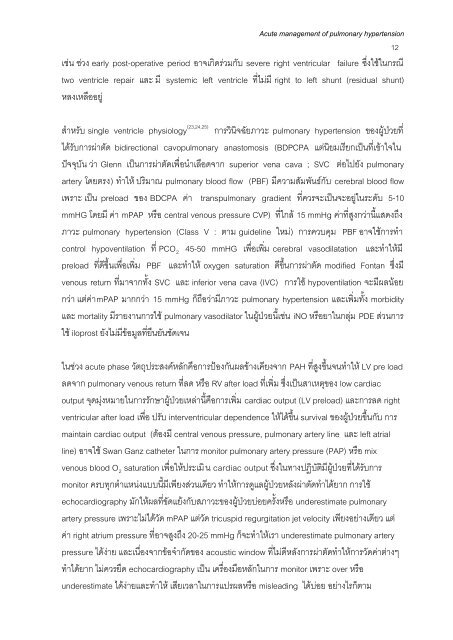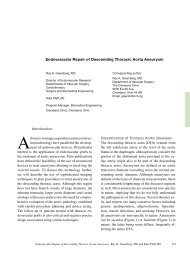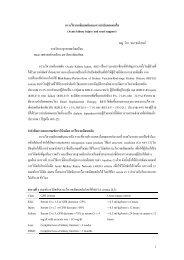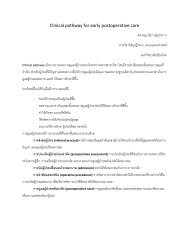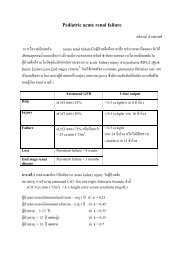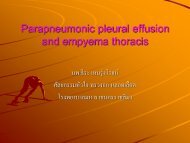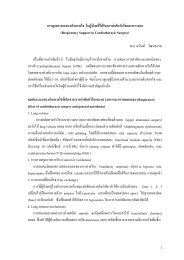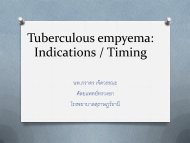Treatment of pulmonary hypertension in congenital heart disease
Treatment of pulmonary hypertension in congenital heart disease
Treatment of pulmonary hypertension in congenital heart disease
Create successful ePaper yourself
Turn your PDF publications into a flip-book with our unique Google optimized e-Paper software.
Acute management <strong>of</strong> <strong>pulmonary</strong> <strong>hypertension</strong>12เชน ชวง early post-operative period อาจเกิดรวมกับ severe right ventricular failure ซึ่งใชในกรณีtwo ventricle repair และ มี systemic left ventricle ที่ไมมี right to left shunt (residual shunt)หลงเหลืออยูสําหรับ s<strong>in</strong>gle ventricle physiology (23,24,25) การวินิจฉัยภาวะ <strong>pulmonary</strong> <strong>hypertension</strong> ของผูปวยที่ไดรับการผาตัด bidirectional cavo<strong>pulmonary</strong> anastomosis (BDPCPA แตนิยมเรียกเปนที่เขาใจในปจจุบัน วา Glenn เปนการผาตัดเพื่อนําเลือดจาก superior vena cava ; SVC ตอไปยัง <strong>pulmonary</strong>artery โดยตรง) ทําให ปริมาณ <strong>pulmonary</strong> blood flow (PBF) มีความสัมพันธกับ cerebral blood flowเพราะ เปน preload ของ BDCPA คา trans<strong>pulmonary</strong> gradient ที่ควรจะเปนจะอยูในระดับ 5-10mmHG โดยมี คา mPAP หรือ central venous pressure CVP) ที่ใกล 15 mmHg คาที่สูงกวานี้แสดงถึงภาวะ <strong>pulmonary</strong> <strong>hypertension</strong> (Class V : ตาม guidel<strong>in</strong>e ใหม) การควบคุม PBF อาจใชการทําcontrol hypoventilation ที่ PCO 2 45-50 mmHG เพื่อเพิ่ม cerebral vasodilatation และทําใหมีpreload ที่ดีขึ้นเพื่อเพิ่ม PBF และทําให oxygen saturation ดีขึ้นการผาตัด modified Fontan ซึ่งมีvenous return ที่มาจากทั้ง SVC และ <strong>in</strong>ferior vena cava (IVC) การใช hypoventilation จะมีผลนอยกวา แตคาmPAP มากกวา 15 mmHg ก็ถือวามีภาวะ <strong>pulmonary</strong> <strong>hypertension</strong> และเพิ่มทั้ง morbidityและ mortality มีรายงานการใช <strong>pulmonary</strong> vasodilator ในผูปวยนี้เชน iNO หรือยาในกลุม PDE สวนการใช iloprost ยังไมมีขอมูลที่ยืนยันชัดเจนในชวง acute phase วัตถุประสงคหลักคือการปองกันผลขางเคียงจาก PAH ที่สูงขึ้นจนทําให LV pre loadลดจาก <strong>pulmonary</strong> venous return ที่ลด หรือ RV after load ที่เพิ่ม ซึ่งเปนสาเหตุของ low cardiacoutput จุดมุงหมายในการรักษาผูปวยเหลานี้คือการเพิ่ม cardiac output (LV preload) และการลด rightventricular after load เพื่อ ปรับ <strong>in</strong>terventricular dependence ใหไดขึ้น survival ของผูปวยขึ้นกับ การma<strong>in</strong>ta<strong>in</strong> cardiac output (ตองมี central venous pressure, <strong>pulmonary</strong> artery l<strong>in</strong>e และ left atriall<strong>in</strong>e) อาจใช Swan Ganz catheter ในการ monitor <strong>pulmonary</strong> artery pressure (PAP) หรือ mixvenous blood O2 saturation เพื่อใหประเมิ น cardiac output ซึ่งในทางปฏิบัติมีผูปวยที่ไดรับการmonitor ครบทุกตําแหนงแบบนี้มีเพียงสวนเดียว ทําใหการดูแลผูปวยหลังผาตัดทําไดยาก การใชechocardiography มักใหผลที่ขัดแยงกับสภาวะของผูปวยบอยครั้งหรือ underestimate <strong>pulmonary</strong>artery pressure เพราะไมไดวัด mPAP แตวัด tricuspid regurgitation jet velocity เพียงอยางเดียว แตคา right atrium pressure ที่อาจสูงถึง 20-25 mmHg ก็จะทําใหเรา underestimate <strong>pulmonary</strong> arterypressure ไดงาย และเนื่องจากขอจํากัดของ acoustic w<strong>in</strong>dow ที่ไมดีหลังการผาตัดทําใหการวัดคาตางๆทําไดยาก ไมควรยึด echocardiography เปน เครื่องมือหลักในการ monitor เพราะ over หรือunderestimate ไดงายและทําให เสียเวลาในการแปรผลหรือ mislead<strong>in</strong>g ไดบอย อยางไรก็ตาม


